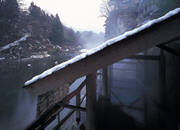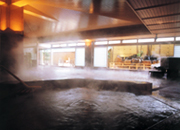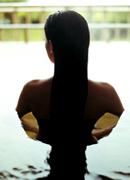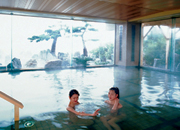| Japanese-style Hotel "Ryokan" |
|
|
|


|
Onsen Ryokans (Ryokans with Hot Spring Baths)
The most widely popular are, no doubt, the onsen ryokans (ryokans with hot spring baths) found all over Japan. In the Japanese archipelago located in the circum-Pacific orogenic belt, there are many newly folded mountains that are still in the process of being formed, with many faults indicating signs of volcanic and seismic activity. These geological features have resulted in the more than 3,000 hot spring resorts to be found in the 47 prefectures of Japan. The properties of hot springs vary enormously, with the hot spring water differing in color, smell and texture from one district to another, and from one hot spring to another. As the remedial effects of the hot spring differ according to the properties of the water, it is important to carefully check where to go if you are seeking therapeutic hot springs (known as toji). Depending on the hot spring, remedial effects can be achieved
not just through bathing, but also by drinking it. If you wish to seek greater medicinal benefits of the hot spring, it may be worth selecting an onsen located near the springhead, with kakenagashi (hot spring water is circulated in the bathtub to keep it fresh and clean) and plentiful hot spring water. In addition to the therapeutic effects of the hot spring, the onsen-loving Japanese really enjoy just immersing their bodies in the hot spring baths. They know that the various services of an onsen ryokan will relieve them of both mental and physical fatigue and will wash away their daily stress. Washing and purifying yourself, stretching out your limbs in the bathtub, your body will start to feel deeply relaxed. Moreover, 'bath communication' of chatting with your companions or exchanging greetings with strangers, is also very soothing. And you will be refreshed by the scenic beauty of the fresh greenery, mountains, rivers, valleys, the sea, the wide blue sky, red and yellow autumn
leaves, snowy landscapes, and so on, when viewed from the bathroom. Stepping out and bathing in a roten-buro (open-air hot spring bath) allows you to enjoy the soothing sounds of nature - the trickling of a stream, the chirping of birds, and the rustling of the wind through the bamboo groves. To relax further, take a deep breath and fill your lungs with pure fresh air. Once you come to understand such subtleties, you have become a veritable onsen-tsu (an onsen expert). |
 |
 |
A winter landscape with a rotenburo
|
 |
A 'daiyokujo' (large common bath)
|
 |
Remedical effects
|
 |
'Bath communication'
|
|
 |